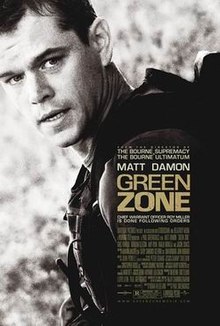
Back Green Zone (cinta) AN المنطقة الخضراء (فيلم) Arabic المنطقة الخضراء ARZ Зелена зона Bulgarian Green Zone Welsh Green Zone German Green Zone (película) Spanish Green Zone (filma) Basque منطقه سبز (فیلم) Persian Green Zone Finnish
| Green Zone | |
|---|---|
 Theatrical release poster | |
| Directed by | Paul Greengrass |
| Written by | Brian Helgeland |
| Based on | Imperial Life in the Emerald City by Rajiv Chandrasekaran |
| Produced by |
|
| Starring | |
| Cinematography | Barry Ackroyd |
| Edited by | Christopher Rouse |
| Music by | John Powell |
Production companies | |
| Distributed by | Universal Pictures[2] |
Release dates |
|
Running time | 115 minutes |
| Country | United Kingdom |
| Language | English |
| Budget | $100 million[2] |
| Box office | $94.9 million[2] |
Green Zone is a 2010 British action thriller film[3] directed by Paul Greengrass and written by Brian Helgeland, based on the 2006 non-fiction book Imperial Life in the Emerald City by journalist Rajiv Chandrasekaran. The book documented life within the Green Zone in Baghdad during the 2003 invasion of Iraq.[4]
The key players in the film are General Mohammed Al-Rawi (Yigal Naor), who is hiding in Baghdad during the invasion of Iraq, and US Army Chief Warrant Officer Roy Miller (Matt Damon), a Mobile Exploitation Team (MET) leader who is searching for Iraqi weapons of mass destruction (WMD). Miller finds that the majority of the intel given to him is inaccurate. His efforts to find the true story about the weapons are blocked by US Department of Defense official Clark Poundstone (Greg Kinnear). The cast also features Brendan Gleeson, Amy Ryan, Khalid Abdalla, and Jason Isaacs.
The film was produced by Universal Pictures, StudioCanal, Relativity Media, Working Title Films, Antena 3 Films, Dentsu, and KanZaman Productions.[5][1] Principal photography began in January 2008 in Spain, later moving to Morocco and the United Kingdom.
Green Zone premiered at the Yubari International Fantastic Film Festival in Japan on 26 February 2010, and was released in Australia, Russia, Kazakhstan, Malaysia and Singapore on 11 March 2010, followed by a further 10 countries the next day, among them the United States, United Kingdom and Canada. The film generally received mixed critical reviews and was a box office bomb, having grossed only $94.9 million against a production budget of $100 million plus $40 million in marketing.[2]
- ^ a b c d e f g h "Green Zone (2010) - Movie". Moviefone. Retrieved 5 November 2024.
- ^ a b c d Cite error: The named reference
mojowas invoked but never defined (see the help page). - ^ "Green Zone is go". Euronews.
- ^ Todd McCarthy (3 April 2010). "Green Zone review". Variety. Retrieved 2 February 2012.
- ^ Rovi: Green Zone - countries, produced by, released by Archived 2013-01-17 at archive.today Retrieved November 4, 2012